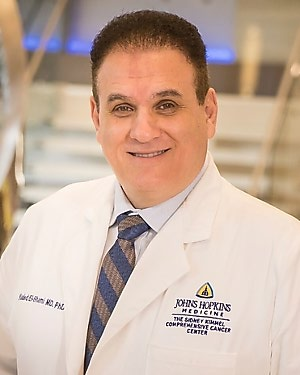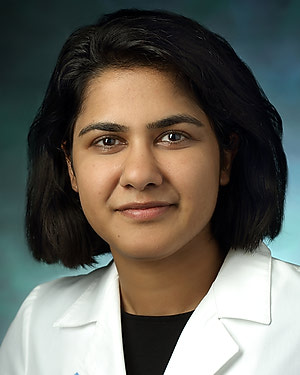-
Alexander Joseph Ambinder, M.D., M.P.H.

Primary Location: Johns Hopkins Sidney Kimmel Comprehensive Cancer Center, Baltimore, MD
-
Amy Elizabeth DeZern, M.D., M.H.S.

Primary Location: Johns Hopkins Sidney Kimmel Comprehensive Cancer Center, Baltimore, MD
-
Khaled Mahmoud El-Shami, M.B.Ch.B., Ph.D., M.S.

Primary Location: Sibley Memorial Hospital, Washington, DC
-
Ivana Gojo, M.D.

Primary Location: Johns Hopkins Sidney Kimmel Comprehensive Cancer Center, Baltimore, MD
-
Tania Jain, M.B.B.S.

Primary Location: Johns Hopkins Sidney Kimmel Comprehensive Cancer Center, Baltimore, MD
-
Gabrielle Tova Prince, M.D.

Primary Location: Johns Hopkins Sidney Kimmel Comprehensive Cancer Center, Baltimore, MD
-
B Douglas Smith, M.D.

Primary Location: Johns Hopkins Sidney Kimmel Comprehensive Cancer Center, Baltimore, MD
-
Jonathan Allen Webster, M.D.

Primary Location: Johns Hopkins Sidney Kimmel Comprehensive Cancer Center, Baltimore, MD
Myelodysplastic Syndrome
Myelodysplastic Syndrome (MDS) refers to a group of disorders in which the bone marrow produces too few mature and/or functioning red blood cells, white blood cells or platelets. It begins with a change to a normal stem cell in the bone marrow. The overall incidence of MDS in the United States is estimated at close to four cases per 100,000 people, with as many as 20,000 to 30,000 people diagnosed annually.
Myelodysplastic Syndrome Experts
Patients are seen in a multidisciplinary myeloid disorders clinic at the Center for Bone Marrow Failures, where patients with difficult cases are discussed by a group of experts who work together to develop short- and long-term goals for the overall best treatment plan. MDS patients are frequently enrolled in ongoing clinical trials. Patients with aggressive forms of MDS that do not respond to traditional chemotherapy have access to innovative leukemia regimens being tested in clinical trials. And some patients may be eligible for potentially curative stem cell transplants, even if they would not normally be on a transplant list because of their age or lack of a donor. Our experts include:
Types of Myelodysplastic Syndrome (MDS)
Low-Risk MDS
There are different types of MDS. It is important to get an accurate diagnosis to get the proper treatment for the type of MDS a person has. Some types, referred to as “low-risk MDS” progress slowly and may cause mild to moderate anemia (a low number of red cells), or decrements to other types of cells.
High-Risk MDS
Other types of MDS called "high-risk MDS" may cause severe problems. In patients with the condition, immature cells called blast cells make up more than 5 percent of the cells in the marrow. In normal conditions, these cells make up less than 5 percent of all cells in the marrow. The result is that the blast cells created do not develop into normal red cells, white cells and platelets, often causing more severe deficits in red blood cells, white blood cells and platelets. The low blood counts can lead to anemia (low red cell count), neutropenia (low neutrophil count, which affects the body’s ability to fight infection) or thrombocytopenia (low platelet count, which affects the body’s ability to help blood to clot).
When MDS patients develop more than 20 percent blast cells, they are reclassified as having acute myelogenous leukemia (AML) with trilineage dysplasia (AML-TLD). Although this is classified as an acute leukemia, many patients continue to progress slowly. Therapies for such patients may be the same as used for patients with other types of high-risk MDS. Alternately, some may be treated using regimens more typically used to treat AML.
Risk Factors
MDS usually occurs in older people, typically starting after age 50, and is rarely inherited. It is more common in men.
For many people, the condition develops without any known cause. In other people, secondary MDS may develop after being exposed to chemotherapy or radiation therapy, or exposure to industrial chemicals such as benzene, that damage the DNA of normal stem cells. Cigarette smoke also may be associated with the condition.
Symptoms
Symptoms of MDS include fatigue and shortness of breath during physical activity, which are common to many diseases. Some patients have no symptoms.
A shortage of red blood cells (anemia) can lead to excessive tiredness, shortness of breath, and pale skin. A shortage of normal white blood cells (leukopenia) can lead to frequent or severe infections. A shortage of blood platelets (thrombocytopenia) can lead to easy bruising and bleeding. Some people notice frequent or severe nosebleeds or bleeding from the gums.
Other symptoms can include weight loss, fever, and loss of appetite.
Diagnostic Tests
If doctors suspect you have MDS, they will need to examine cells from your blood and bone marrow to confirm the diagnosis. A blood test called a complete blood count (CBC) measures the amounts of different cells in the blood, such as the red blood cells, the white blood cells, and the platelets. Patients with MDS often have too few red blood cells, and may also have shortages of white blood cells and platelets. Some MDS patients’ blood samples contain blast cells. This is abnormal and often signals a bone marrow problem. Blood cells from MDS patients may also have abnormal sizes, shapes, or other features that can be seen under the microscope.
Doctors also need to do a bone marrow aspiration or a bone marrow biopsy, two tests that involve taking a sample of cells or tissue from the bone marrow to examine for abnormalities under a microscope. For both procedures, you lie on an examining table. The doctor will numb the skin over the hip and then insert a thin hollow needle into the bone to extract a small piece of bone and/or some liquid marrow. The doctors will look at the size and shape of the cells and determine the percentage of marrow cells that are blasts.
A diagnosis of MDS is based on the presence of at least one of the following:
- More than 5 percent of the marrow cells are blast cells.
- Genetic abnormalities seen in the cells.
- Abnormal shape of cells in the blood or bone marrow.
Risk Classification
Different clinical features will help your physician classify your MDS and give some idea of the natural course of disease and how best to treat you.
The Revised International Prognostic Scoring System (IPSS-R) is one way to define MDS at the time of diagnosis. It rates factors such as the subtype of MDS, the number and severity of low blood cell counts, and the percentage of blast cells in the bone marrow. Each factor is given a score, with lower scores having a better outlook. The scores are added together to place people with MDS into five groups, ranging very low to very high risk.
The World Health Organization has its own MDS classification system known as the WHO Prognostic Scoring System (WPSS), which can be used throughout the course of the disease.
Johns Hopkins experts also consider a patient’s molecular mutations when assessing risk. This is not yet part of the IPSS-R.

Current Treatments
Doctors are still working on a cure for MDS, though there are many ways to manage the disease. Patients with very low risk who do not need blood transfusions may be able to go without treatment for years, as long as they are checked regularly by a doctor. Other patients need more aggressive therapies. One treatment regimen that has worked for some patients is high doses of chemotherapy followed by a stem cell transplant. Other MDS treatments aim to reduce the need for blood transfusions, decrease the risk of infection and increase quality of life.
Blood transfusions
Some patients may need red cell to relieve symptoms of fatigue and shortness of breath. Blood transfusions increase the number of normal red blood cells in circulation, helping to relieve anemia. Platelet transfusions may be given to prevent or stop bleeding if platelet counts are very low.
During a transfusion, a technician will hang a bag containing the blood product you are receiving from a pole, then insert a narrow tube into a blood vessel in your arm. The healthy blood from a donor will drip from the bag through the tube and into your vein. The procedure usually takes about one to two hours, depending on what blood component(s) you are receiving. Most people do not experience side effects from the procedure. Possible side effects include fever, allergic reaction or infection. Transfusions also increase the buildup of iron in the body, which, untreated, could lead to organ damage. Patients who have ongoing transfusion need to be monitored for "iron overload"—a condition that can damage the heart and liver—with a blood test to measure the body's store of iron. If it is too high, medications to remove excess iron may be prescribed.
Growth factors
Giving extra doses of hormone-like substances that stimulate bone marrow to produce blood cells, called hematopoietic growth factors, can help the blood counts of MDS patients to become more normal. { Erythropoietin (Epo or Procrit), a growth factor that promotes red blood cell production, can help avoid red blood cell transfusions in some patients. Darbepoetin alfa (Aranesp) is a long-acting form of erythropoietin. Patients should be selected for treatment with these drugs based on the level of erythropoietin which their body makes (this can be determined by a blood test) and by transfusion needs. In general, patients who respond best are those who do not need a lot of transfusions. Growth factors are usually administered through injections under the skin. Side effects include red, itchy skin; fever, chills or fluid retention; and bone pain.
The growth factors granulocyte colony stimulating factor (G-CSF, neupogen, or filgrastim) and granulocyte macrophage-colony stimulating factor (GM-CSF or sargramostim) can improve white blood cell production among MDS patients with frequent infections. Pegfilgrastim (Neulasta) is a long-acting form of G-CSF. In general, there is no evidence that these should be used with MDS patients with low white counts who are not having frequent infections. These growth factors can increase the number of patients whose anemia improves when given together with Epo or Aranesp.
Medications
One class of medications used in the treatment of MDS is called - DNA methyltransferase inhibitors (sometimes called hypomethylating agents). These drugs are a form of chemotherapy that affect the way genes are controlled; they slow down genes that promote cell growth and kill cells that are dividing rapidly. Examples of this type of drug include azacytidine (Vidaza) and decitabine (Dacogen). In some MDS patients, these drugs improve blood counts, lower the chance of getting leukemia, and, in the case of azacytidine, prolong life. Red blood cell counts may improve enough to stop transfusions. These drugs have mild side effects including fatigue and temporary lowering of the blood counts.
Other drugs used for MDS include lenalidomide (Revlimid) and combination decitabine/cedazuridine (Inqovi). Revlimid, which is administered orally, may work well in low-grade MDS, eliminating the need for transfusions in about a quarter of the patients treated. The drug works much better in patients whose MDS cells are missing a part of chromosome number 5. Seventy-five percent of such patients will no longer need transfusions when treated. Side effects include decreased blood counts (most often the white cell count and platelet count), diarrhea or constipation, and fatigue and weakness.
Inqovi, which used to be available only as an infusion, is now available as pills. It is intended for adults with intermediate- and high-risk types of myelodysplastic syndromes (MDS), including chronic myelomonocytic leukemia (CMML). In clinical trials, the drug helped some patients achieve a complete response and others eliminate the need for blood transfusions. The most common side effects include low blood cell counts, low platelets, fatigue, constipation, bleeding, muscle and joint pain, and dizziness.
Medications that lower the immune system (immunosuppressants) improve blood counts in some patients with MDS. These drugs include include anti-thymocyte globulin (ATG), which work against a type of white blood cell called T-lymphocytes that help control immune reactions. In some patients with MDS, T-lymphocytes interfere with normal blood cell production. Cyclosporine A is given orally; ATG is given as an infusion through a vein. It must be given in the hospital because it can sometimes cause severe allergic reactions leading to low blood pressure and problems breathing.
Cyclosporine is another drug that works by suppressing the immune system. It was first used to block immune responses in people who have had organ or bone marrow transplants, but, it has helped some patients with MDS. Side effects of cyclosporine include loss of appetite and kidney damage. Your doctor will determine if you are an appropriate candidate for any of these medications.
Bone marrow transplant / Stem cell transplant
A bone marrow transplant is the only treatment known to cure MDS. It gives a patient healthy stem cells – immature cells that grow into different parts of the blood – taken from the marrow, the soft, fatty tissue inside the bones, replacing the diseased MDS bone marrow. It is recommended that MDS patients get stem cells from a relative or other donor, since their own bone marrow contains abnormal cells.
Most patients get high doses of chemotherapy, radiation, or both, before the bone marrow transplant to kill any cancer cells that might remain and make room for new stem cells to grow. Doctors then deliver the stem cells through a tube injected into the bloodstream. They find their way into the bone marrow and begin reproducing to make healthy new blood cells. While receiving stem cells, patients may experience pain, chills, fever, hives, chest pain or other symptoms.
Doctors may also recommend a reduced-intensity transplant that gives lower doses of chemotherapy and/or radiation. These doses are not high enough to kill all the bone marrow cells but are just enough to allow the donor cells to take hold.
Chemotherapy
Because MDS can progress to acute leukemia, patients are often treated with regimens used in that disease. These treatments usually require patients to stay in the hospital for several weeks. Chemotherapy reduces the the abnormal stem cells and allows healthy ones to grow back. These effects are temporary unless followed by a bone marrow transplant. Doctors may recommend one medication or a combination of drugs, which may be administered either as quick injections or as slow infusions into your veins, though some may be taken as pills. Chemotherapy is typically administered every two to three weeks for a number of cycles. Side effects can depend on which drugs were given and how much, but include fatigue, hair loss, poor appetite, nausea or vomiting, diarrhea, or infertility.
MDS Research, Treatment: "Fixing the Unfixable" at Johns Hopkins
MDS treatments focus on improving blood counts, quality of life and preventing or delaying progression to more severe forms of leukemia. This is particularly important because the more aggressive forms of leukemia associated with MDS do not respond well to chemotherapy. When MDS patients develop acute leukemia, it is typically treated with stem cell transplantation to replace defective bone marrow. Doctors at Hopkins pioneered both stem cell transplantation and bone marrow transplantation and remain leaders in improving the effectiveness and safety of these vital procedures.
To help expand treatment options for MDS, Johns Hopkins researchers performed a series of clinical trials using drugs which may restore the normal function of genes. One MDS survivor treated at the Center in those ground-breaking clinical trials said, “I came to the Kimmel Cancer Center thinking I had two years to live, but these doctors are amazing in what they have figured out. I think they thrive on fixing the unfixable.”
The trials focusing on MDS built upon pioneering research at Johns Hopkins in DNA methylation, an epigenetic change that alters tumor suppressor genes so that they do not stop the growth of cancer cells. This cancer biology research was recognized in 2004 by the National Cancer Institute as “most outstanding” in its state-of-the art Specialized Program of Research Excellence (SPORE). The research team was cited as a “research powerhouse” by Science Watch, because its work is the most frequently referenced research by other cancer researchers worldwide.
Johns Hopkins Kimmel Cancer Center investigators are actively involved in leading and contributing to clinical trials for novel therapies and treatment regimens.
Myelodysplastic Syndrome Research Leads the Way
Physician scientists with the Kimmel Cancer Center at Johns Hopkins have led the way in two approaches to MDS:
- The first uses medications that target epigenetic changes – changes affecting gene expression within cells – with the idea to get MDS to behave more normally. One such drug tested at Johns Hopkins and other centers, called 5-aza-cytidine, has been approved by the U.S. Food and Drug Administration for clinical use in MDS patients.
- Another method, done through clinical trials, aims to get cancer cells to behave more normally through medications that help the cells mature correctly.
At the Johns Hopkins Kimmel Cancer Center, researchers currently are testing new approaches to help MDS patients, including:
- Leading a national study to test how azacitidine, the drug used to reverse DNA methylation, is working, and to improve its outcomes using another class of novel drugs
- A new trial that aims to extend the utility of lenalidomide, a drug currently used in a small subset of MDS patients
- A tumor vaccine to boost the immune systems of MDS patients and improve their bone marrow function
- High-dose therapies for patients with advanced, high-risk MDS.
